
Earl of Home is a title in the Peerage of Scotland. It was created in 1605 for Alexander Home of that Ilk, 6th Lord Home. The Earl of Home holds, among others, the subsidiary titles of Lord Home and Lord Dunglass (1605) in the Peerage of Scotland, and Baron Douglas, of Douglas in the County of Lanark (1875), in the Peerage of the United Kingdom. Various Earls of Home have also claimed the title of Lord Hume of Berwick. The Earl is also Chief of the Name and Arms of Home and heir general to the House of Douglas. The title of Lord Dunglass is used as a courtesy title by the eldest son of the Earl.

Earl of Kimberley, of Kimberley in the County of Norfolk, is a title in the Peerage of the United Kingdom. It was created in 1866 for the prominent Liberal politician John Wodehouse, 3rd Baron Wodehouse. During his long political career, he notably held office as Lord Lieutenant of Ireland, Secretary of State for the Colonies, Secretary of State for India and Secretary of State for Foreign Affairs. He was succeeded by his son, the second Earl. At first a Liberal like his father, he later joined the Labour Party, becoming the first Labour member of the House of Lords. His eldest son, the third Earl, represented Norfolk Mid in the House of Commons as a Liberal. Since 2002, the titles are held by the latter's grandson, the fifth Earl.

Viscount Knollys, of Caversham in the County of Oxford, is a title in the Peerage of the United Kingdom. It was created in 1911 for the court official Francis Knollys, 1st Baron Knollys, Private Secretary to the Sovereign from 1901 to 1913. He had been previously created Baron Knollys, of Caversham in the County of Oxford, on 21 July 1902. His son, the second Viscount, served as Governor of Bermuda. As of 2023 the titles are held by the latter's grandson, the fourth Viscount, who succeeded in 2023. The third Viscountess Knollys was a sister of Baron Farnham: she served as Vice Lord-Lieutenant of Norfolk.
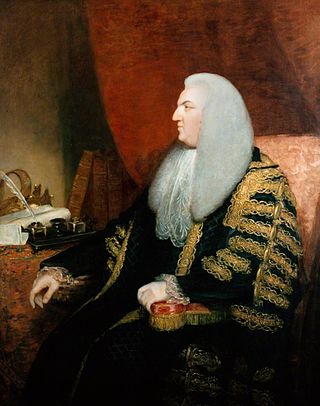
Baron Grantley, of Markenfield, in the County of York is a title in the Peerage of Great Britain. It was created on 9 April 1782 for Sir Fletcher Norton, Attorney General from 1763 to 1765 and Speaker of the House of Commons from 1770 to 1780. His son, the second Baron, was also a politician and represented Richmond, Wigtown Burghs, Guildford and Surrey in Parliament. He was succeeded by his nephew, Fletcher Norton, the third Baron. He was childless and on his death the title passed to his nephew, the fourth Baron. As of 2017 the title is held by the latter's great-great-grandson, the eighth Baron, who succeeded his father in 1995.

Baron Kenyon, of Gredington, in the County of Flint, is a title in the Peerage of Great Britain. It was created in 1788 for the lawyer and judge Sir Lloyd Kenyon, 1st Baronet. He served as Master of the Rolls and as Lord Chief Justice of England and Wales. Kenyon had already been created a Baronet, of Gredington in the County of Flint, in 1784. His grandson, the third Baron, briefly represented St Michael's in the House of Commons. His grandson, the fourth Baron, held minor office in the governments of Lord Salisbury, Arthur Balfour and David Lloyd George and also served as Lord Lieutenant of Denbighshire. In 1912 Lord Kenyon assumed by Royal licence the additional surname of Tyrell. As of 2019 the titles are held by his great-grandson, the seventh Baron, who succeeded his father in 2019.
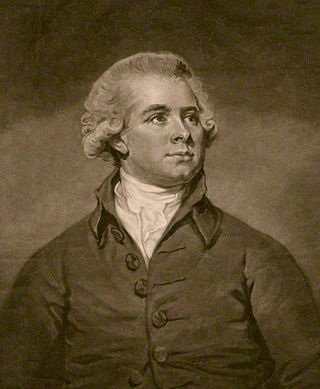
Baron Henniker, of Stratford-upon-Slaney in the County of Wicklow, is a title in the Peerage of Ireland. It was created in 1800 for Sir John Henniker, 2nd Baronet, who had previously represented Sudbury and Dover in the House of Commons. His son, the second Baron, also sat as a Member of Parliament. In 1792 he assumed by Royal licence the additional surname of Major. He was childless and was succeeded by his nephew, the third Baron. He assumed the additional surname of Major by Royal licence in 1822. His son, the fourth Baron, represented Suffolk East in Parliament. In 1866 he was created Baron Hartismere, of Hartismere in the County of Suffolk, in the Peerage of the United Kingdom. This title gave him and his descendants an automatic seat in the House of Lords. He was succeeded by his son, the fifth Baron. He also sat as Member of Parliament for Suffolk East and later held minor office in the Conservative administrations of Benjamin Disraeli and Lord Salisbury. His grandson, the eighth Baron, was a prominent diplomat and notably served as British Ambassador to Jordan and to Denmark. As of 2014 the titles are held by the latter's son, the ninth Baron, who succeeded in 2004.

Baron Henley is a title that has been created twice: first in the Peerage of Great Britain and then in the Peerage of Ireland. The first creation came in 1760 in favour of Sir Robert Henley, Lord High Chancellor of Great Britain, when he was created Lord Henley, Baron of Grainge, in the County of Southampton. In 1764 he was further honoured when he was made Earl of Northington. On the death of his son, the second Earl, both titles became extinct. Lady Elizabeth Henley, youngest daughter of the first Earl and co-heiress of the second Earl, married the diplomat Morton Eden. In 1799, the Henley title was revived when Eden was created Baron Henley, of Chardstock in the County of Dorset, in the Peerage of Ireland. Their son, the second Baron, assumed the surname of Henley in lieu of Eden and notably published a biography of his maternal grandfather. His son, the third Baron, sat as Liberal Member of Parliament for Northampton. In 1885 the Northington title was also revived when he was created Baron Northington, of Watford in the County of Northampton, in the Peerage of the United Kingdom. This title gave the Barons an automatic seat in the House of Lords. The fourth baron Frederick Henley was an educated man who served as JP in Northamptonshire and married Augusta, daughter of Herbert Langham 12th baronet.

Baron Harris, of Seringapatam and Mysore in the East Indies and of Belmont in the County of Kent, is a title in the Peerage of the United Kingdom.

Baron Heytesbury, of Heytesbury in the County of Wiltshire, is a title in the Peerage of the United Kingdom. It was created in 1828 for the prominent politician and diplomat Sir William à Court, 2nd Baronet, who later served as Ambassador to Russia and as Viceroy of Ireland. His son, the second Baron, sat as Member of Parliament for the Isle of Wight. On his marriage in 1837 to Elizabeth Holmes, daughter of Sir Leonard Worsley Holmes, Lord Heytesbury assumed the additional surname of Holmes. His son the 4th baron commanded a battalion in the Wiltshire Regiment and was for a time in command of 62nd (Wiltshire) Regiment of Foot. As of 2010, the titles are held by his great-great-great-grandson, the seventh Baron, who succeeded his father in 2004.

Baron Hatherton, of Hatherton in the County of Stafford, is a title in the Peerage of the United Kingdom. It was created in 1835 for the politician Edward Littleton, Chief Secretary for Ireland from 1833 to 1834. Born Edward Walhouse, he assumed in 1812 by Royal licence the surname of Littleton in lieu of his patronymic on succeeding to the estates of his great-uncle Sir Edward Littleton, 4th and last Baronet, of Teddesley Hall. He was also heir to the substantial Walhouse estates and interests, which included Hatherton Hall, near Cannock, then in an exclave of Wolverhampton. His wealth was based upon landed estates centred on Penkridge in southern Staffordshire, mines at Great Wyrley and Bloxwich, quarries and sandpits, brick yards and residential housing, mainly in Walsall.

Baron Harlech, of Harlech in the County of Merioneth, is a title in the Peerage of the United Kingdom. It was created in 1876 for the Conservative politician John Ormsby-Gore, with remainder to his younger brother William. He had previously represented Carnarvon and North Shropshire in the House of Commons. Ormsby-Gore was the eldest son of William Ormsby-Gore, Member of Parliament for County Leitrim, Carnarvon and North Shropshire, and the great-great-great-grandson of William Gore, third and youngest son of Sir Arthur Gore, 1st Baronet, of Newtown, second son of Sir Paul Gore, 1st Baronet, of Magharabag, whose eldest son Paul was the grandfather of Arthur Gore, 1st Earl of Arran.
Baron Hothfield, of Hothfield in the County of Kent, is a title in the Peerage of the United Kingdom. It was created in 1881 for Sir Henry Tufton, 2nd Baronet, who was appointed Lord Lieutenant of Westmorland the same year and who also served briefly as a government whip in the Liberal administration of 1886. His eldest son, the second Baron, notably served as Mayor of Appleby, Westmorland. On the death of his son, the third Baron, in 1961, this line of the family failed. The late Baron was succeeded by his first cousin, the fourth Baron. He was the only son of the Hon. Sackville Philip Tufton, second son of the first Baron. On his death in 1986 this line of the family also failed and the titles passed to his first cousin, the fifth Baron. He was the eldest son of the Hon. Charles Henry Tufton, third son of the first Baron. As of 2017 the titles are held by his son, the sixth Baron, who succeeded in 1991.
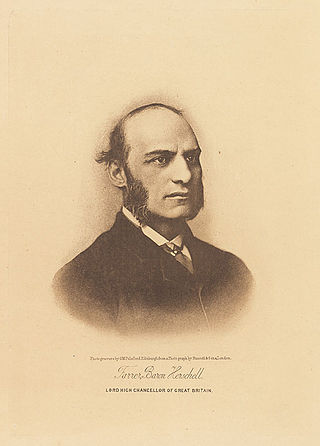
Baron Herschell, of the City of Durham, was a title in the Peerage of the United Kingdom. It was created on 8 February 1886 for the lawyer and Liberal politician Sir Farrer Herschell. He served as Lord Chancellor in 1886 and from 1892 to 1895. The title became extinct on the death of his grandson, the third Baron, in 2008.

Baron Hindlip, of Hindlip in the County of Worcester and of Alsop-en-le-Dale in the County of Derby, is a title in the Peerage of the United Kingdom. It was created in 1886 for the businessman and Conservative politician Sir Henry Allsopp, 1st Baronet. He was head of the brewing firm of Samuel Allsopp & Sons of Burton upon Trent, and he also represented East Worcestershire in Parliament.
Baron Hamilton of Dalzell, in the County of Lanark, is a title in the Peerage of the United Kingdom. It was created in 1886 for the Liberal politician John Hamilton. He had previously represented Falkirk and Lanarkshire South in the House of Commons and after his elevation to the peerage served under William Ewart Gladstone as a Government Whip from 1892 to 1894. His eldest son, the second Baron, was a Government Whip from 1905 to 1911 in the Liberal administrations of Henry Campbell-Bannerman and H. H. Asquith and also served as Lord Lieutenant of Lanarkshire. His nephew, the third Baron, was Lord Lieutenant of Surrey. As of 2010 the title is held by the latter's grandson, the fifth Baron, who succeeded his father in 2006.
Baron Joicey, of Chester-le-Street in the County of Durham, is a title in the Peerage of the United Kingdom. It was created in 1906 for the coal mining magnate and former Liberal Member of Parliament for Chester-le-Street, Sir James Joicey, 1st Baronet. He had already been created a baronet, of Longhirst and of Ulgham, both in the County of Northumberland, in the Baronetage of the United Kingdom in 1893. He was succeeded by his eldest son, the second Baron. He was High Sheriff of County Durham in 1910. The second baron lost his son young, and on his death his younger brother succeeded to the barony. The third Baron was an army officer, whose elder son died in WWII without male issue, and he was thus succeeded by his younger son, the fourth baron. As of 2010 the titles are held by the latter's eldest son, the fifth Baron, who succeeded in 1993.
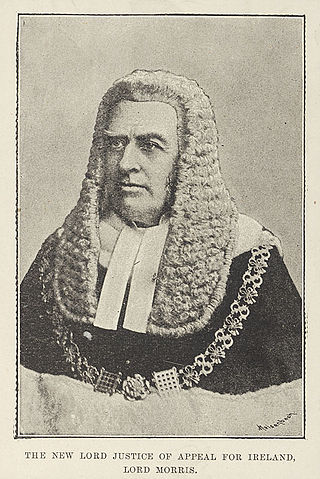
Baron Killanin, of Galway in the County of Galway, is a title in the Peerage of the United Kingdom.

Baron Kilbracken, of Killegar in the County of Leitrim, is a title in the Peerage of the United Kingdom. It was created in 1909 for the senior civil servant Sir Arthur Godley. He was Permanent Under-Secretary of State for India between 1883 and 1909. As of 2010 the title is held by his great-grandson, the fourth Baron, who succeeded his father in 2006.

Baron Lawrence, of the Punjab and of Grateley in the County of Southampton, was a title in the Peerage of the United Kingdom. It was created in 1869 for Sir John Lawrence, 1st Baronet, the former Viceroy of India. He had already been created a Baronet, in 1858. His son, the second Baron, served in the Conservative administrations of Lord Salisbury and Arthur Balfour as a government whip from 1895 to 1905. The title became extinct on the death of the fifth Baron on 14 August 2023.
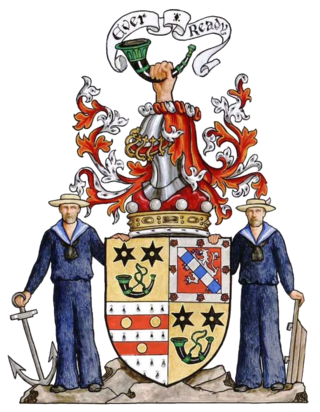
Baron Inverclyde, of Castle Wemyss in the County of Renfrew, was a title in the Peerage of the United Kingdom. It was created in 1897 for the Scottish shipowner Sir John Burns, 2nd Baronet. The Baronetcy had been created in the Baronetage of the United Kingdom in 1889 for George Burns. The titles became extinct on the death without issue of the fourth Baron in 1957.

















